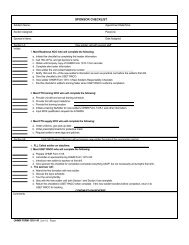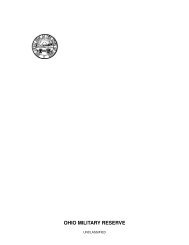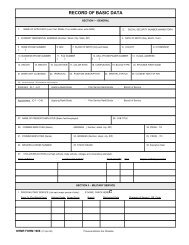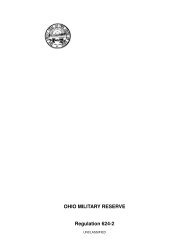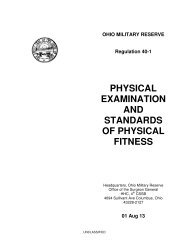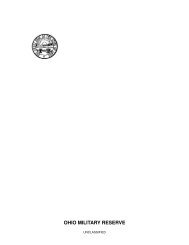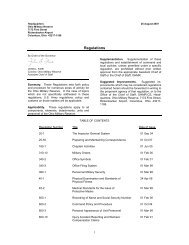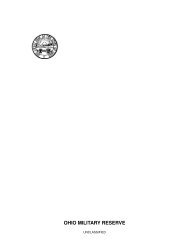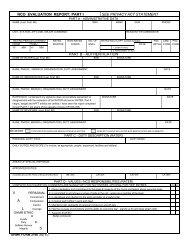quick response security training (qrst) - Ohio Military Reserve
quick response security training (qrst) - Ohio Military Reserve
quick response security training (qrst) - Ohio Military Reserve
Create successful ePaper yourself
Turn your PDF publications into a flip-book with our unique Google optimized e-Paper software.
OHMR-G3 (QRST)SUBJECT: Quick Response Security Training (Teams) SOP 405.00<strong>training</strong> previously completed. Under extenuating circumstances, the QRST Coordinator (G3) may grantone or more extensions to the eighteen month time frame.10. DISTINCTIVE TABThe QRST tab (see Annex C) will be awarded at an appropriate ceremony to those personssuccessfully completing all <strong>training</strong> requirements. The tab will be embroidered in the traditional militarypolice colors; the background will be green with the lettering and border golden yellow. It will be worndirectly above the OHMR shoulder patch on the left sleeve with the lowest points touching the top of theshoulder patch. The tab will be worn on the Army service green coat, the Class “C” shirt , and the fieldjacket. Retirees may wear the tab directly above and touching the retiree’s shoulder patch.11. EMPLOYMENTa. As stated earlier, the mission oriented purpose of the QRST program is to provide thecommander with highly trained personnel who are capable of rapid and flexible <strong>response</strong> to assist in a<strong>Military</strong> Support to Civil Authorities (MSCA) mission and who have skills and <strong>training</strong> beyond what isnormally required of OHMR personnel. They can be the commander’s “eyes and ears” on site, acting asan advance party and liaison between civil authorities and the incoming unit. They may be the first OHMRpersonnel to meet with the civilian Incident Commander; may select dismount and assembly points, andmay locate the initial CP. Because they will be first on the scene after the request for military support hasbeen made (and presumably after the situation has overtaxed civilian resources) they must be preparedfor the unlikely event that they will have to respond to problems or threats with little or no support. Their<strong>training</strong> is designed to give them a broad base of knowledge, keep their thinking flexible and optionoriented,and give them confidence in their abilities.b. There will be no QRST units, only QRST qualified personnel scattered throughout variousunits. Each S-3 will maintain a current list of QRST qualified personnel within the unit. A unit QRSTcoordinator may be assigned, if desired.c. Upon activation for a MSCA mission, the unit commander may chose to activate a QRSTteam, especially if no OHMR liaison officer is at the place where the unit is going. At the commander’sdirection, the S-3 (or unit QRST coordinator) will contact the required number of QRST personnel fromwithin the activated unit and direct them to activate immediately. They will be given instructions on:1). who is going and who is the team leader;2). where they are to meet and where they are to go;3). what they are supposed to do on arrival and what information is needed;4). when they are to arrive on the scene;5). how they are to travel and how they are to report information to the S3d. QRST teams should consist of three to six persons, depending on the size and scope of themission. The team should be totally self sufficient, carrying rations, water, and shelter for forty-eighthours.e. QRST teams may be used as physical <strong>security</strong> specialists for protecting facilities, property, orpersons. This may be in conjunction with a MSCA mission or a solely military mission. They may assumethe <strong>security</strong> mission totally or they may be used as a <strong>training</strong> cadre and/or supervisory element for othertroops.f. QRST teams may be utilized as damage assessment teams. It is recommended that prior tosuch employment, they complete a damage assessment course through FEMA, the Red Cross or asimilar agency, but it is not mandatory.g. QRST teams may be utilized as “pathfinder” teams. In this role they would locate and mark asafe, passable and secure avenue of approach to the disaster area for the incoming force. It may benecessary to utilize some QRST personnel as guides for entry into particularly hazardous or complicatedareas.h. Upon completion of their assignment, the QRST team is disbanded at the direction of thecommander who authorized their employment and the soldiers immediately returned to their units.3



